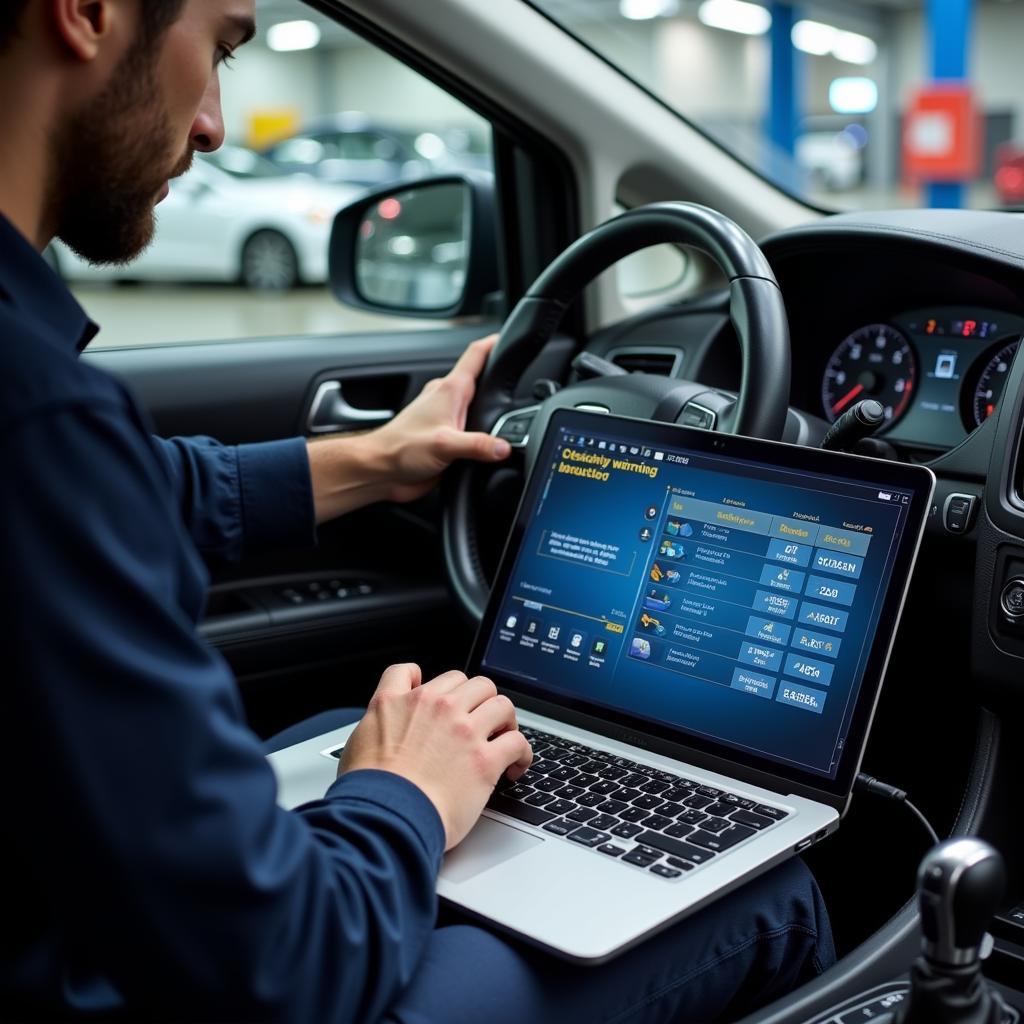A collision warning system with full auto brake is a crucial safety feature in modern vehicles. It’s designed to assist drivers in avoiding or mitigating frontal collisions by providing warnings and automatically applying the brakes if necessary. Understanding how this system operates can not only enhance your driving safety but also potentially save lives.
How Does “Collision Warning Full Auto Brake” Work?
This advanced safety feature utilizes sensors, typically cameras, radar, or a combination of both, to constantly monitor the distance and closing speed to vehicles in front. When the system detects an impending collision, it issues a series of warnings to the driver.
 Collision Warning System Sensors
Collision Warning System Sensors
These warnings can be visual, such as a flashing icon on the dashboard, or audible, like a beeping sound that intensifies as the danger increases. If the driver fails to respond to these warnings and the system determines that a collision is imminent, it will automatically engage the brakes. This automatic braking feature is designed to either prevent the collision altogether or significantly reduce the severity of the impact.
Common Causes of “Collision Warning Full Auto Brake” Malfunctions
While this safety system is incredibly sophisticated, it’s not entirely immune to malfunctions. Several factors can lead to issues, ranging from sensor obstructions to software glitches. Understanding these common culprits can help you address or prevent problems:
- Dirty or Obstructed Sensors: Since the system heavily relies on its sensors, even a minor obstruction, such as dirt, snow, or ice, can hinder their functionality. This can trigger false warnings or prevent the system from engaging when necessary.
- Software Issues: Like any computer-based system, the collision warning system depends on software. Software bugs or outdated versions can lead to malfunctions, requiring updates or recalibrations.
- Sensor Misalignment: Accidents or even minor fender benders can cause the sensors to become misaligned. This misalignment can disrupt the accuracy of the system, leading to inaccurate readings and potential malfunctions.
- Electrical Problems: Issues within the vehicle’s electrical system, such as faulty wiring or a weak battery, can also affect the collision warning system.
Troubleshooting Tips for “Collision Warning Full Auto Brake”
Experiencing issues with your collision warning system can be concerning, but there are steps you can take to troubleshoot and potentially resolve minor problems:
- Check Your Sensors: Regularly inspect your vehicle’s sensors, ensuring they are clean and free of any obstructions.
- Consult Your Owner’s Manual: Your owner’s manual provides vehicle-specific information and troubleshooting tips for your specific make and model.
- Check for Software Updates: Manufacturers often release software updates to address bugs and improve system performance. Consult your dealership or manufacturer’s website for any available updates.
- Seek Professional Assistance: If the issue persists, it’s crucial to seek professional help. A qualified mechanic specializing in automotive electronics can diagnose and address more complex problems.
“It’s crucial to remember that regular maintenance and timely attention to warning signs are key to ensuring the optimal performance of your vehicle’s safety systems,” says John Smith, Senior Automotive Engineer at Car Tech Solutions. “Addressing potential issues early can prevent more significant problems down the line.”
Remote Diagnostics and Software Solutions for “Collision Warning Full Auto Brake”
The advancement in automotive technology has led to the emergence of remote diagnostics and software solutions that can address certain issues with your car’s systems, including the collision warning system.
 Remote Diagnostics for Collision Warning
Remote Diagnostics for Collision Warning
These remote solutions involve connecting your vehicle to a diagnostic tool that communicates with the car’s computer system. Through this connection, technicians can remotely identify software glitches, update software, and sometimes even recalibrate sensors without requiring a physical visit to the repair shop.
collision warning met full auto brake
Importance of Professional Servicing
While remote diagnostics and basic troubleshooting can be helpful for minor issues, it’s essential to understand that professional servicing is crucial for maintaining the integrity of your car’s safety systems, especially a complex one like the collision warning system with full auto brake.
“Attempting to repair or modify the system yourself can be dangerous and potentially void your vehicle’s warranty,” advises John Smith. “Always trust qualified professionals for any significant repairs or software modifications.”
FAQs About “Collision Warning Full Auto Brake”
Q: How can I tell if my collision warning system is malfunctioning?
A: Common signs include frequent false warnings, no warnings when a collision seems imminent, or warning lights remaining on even when there are no obstacles.
Q: Can I temporarily disable the collision warning system?
A: While the process varies depending on the car model, most vehicles allow you to temporarily turn off the system. However, it’s generally not recommended to drive with the system deactivated.
Q: Does the collision warning system work at all speeds?
A: While the system is designed to function within a specific speed range, this range can vary between manufacturers and models. Refer to your owner’s manual for details.
Q: Will the collision warning system prevent all accidents?
A: It’s important to remember that the system is an assist feature, not a guarantee against all collisions.
Q: Where can I get my collision warning system serviced?
A: Your dealership or a qualified mechanic specializing in automotive electronics can diagnose and service your collision warning system.
Conclusion
The “collision warning full auto brake” system is a testament to the rapid advancements in automotive safety technology, playing a critical role in mitigating and preventing accidents. Understanding how it operates, recognizing potential issues, and seeking professional help when needed can significantly enhance your safety on the road.
